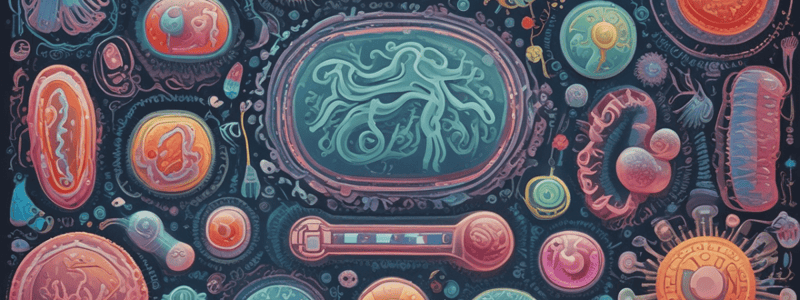Podcast
Questions and Answers
What is the primary characteristic of a classical infection?
What is the primary characteristic of a classical infection?
- It is caused by a single organism (correct)
- It involves multiple microorganisms
- It is caused by an exogenous source
- It involves a mixture of bacteria and viruses
What is the mechanism by which bacteria adhere to lung tissue in secondary infections?
What is the mechanism by which bacteria adhere to lung tissue in secondary infections?
- The bacterial neuraminidase cleaves sialic acid residues on host cells (correct)
- The host immune response produces antibodies against the bacteria
- The bacteria produce toxins that disrupt the host cell membrane
- The viral protease cleaves bacterial cell walls
What is an example of a primary infection?
What is an example of a primary infection?
- Bronchitis
- Anthrax
- Influenza (correct)
- Pneumonia
What is the main trigger for secondary infections?
What is the main trigger for secondary infections?
What is the final step in the mechanism of a classical infection?
What is the final step in the mechanism of a classical infection?
What is an example of a polymicrobial infection?
What is an example of a polymicrobial infection?
What is the result of dysbiosis and pathogenic biofilm formation?
What is the result of dysbiosis and pathogenic biofilm formation?
What type of polymicrobial interaction leads to quorum sensing?
What type of polymicrobial interaction leads to quorum sensing?
What is the role of adhesins in co-aggregation?
What is the role of adhesins in co-aggregation?
What is the result of Candida albicans and S. aureus co-aggregation in denture stomatitis?
What is the result of Candida albicans and S. aureus co-aggregation in denture stomatitis?
What is the effect of farnesol on Candida albicans?
What is the effect of farnesol on Candida albicans?
What is the purpose of digestive consortiums?
What is the purpose of digestive consortiums?
How can some microbes survive in harsh lethal environments?
How can some microbes survive in harsh lethal environments?
What is the minimum requirement for polymicrobial co-operation in a dental abscess?
What is the minimum requirement for polymicrobial co-operation in a dental abscess?
What is the drawback of using 16S rRNA Next-Generation Sequencing and OTU determination to detect microbes?
What is the drawback of using 16S rRNA Next-Generation Sequencing and OTU determination to detect microbes?
Why is the outcome of treatment to polymicrobial infections difficult to predict?
Why is the outcome of treatment to polymicrobial infections difficult to predict?
What is the primary consequence of an overactive immune system in response to a viral infection?
What is the primary consequence of an overactive immune system in response to a viral infection?
What is the primary reason why antibiotics are not recommended to treat viral diseases?
What is the primary reason why antibiotics are not recommended to treat viral diseases?
What is the term for the matrix-enclosed population of microbes that can adhere to biotic and abiotic substrates?
What is the term for the matrix-enclosed population of microbes that can adhere to biotic and abiotic substrates?
What is the primary mechanism by which primary colonizers interact with the conditioning film in biofilm development?
What is the primary mechanism by which primary colonizers interact with the conditioning film in biofilm development?
What is the term for the process by which a mature multi-species biofilm develops from a primary colonizer?
What is the term for the process by which a mature multi-species biofilm develops from a primary colonizer?
What is the primary component of enamel that starts the development of plaque biofilm?
What is the primary component of enamel that starts the development of plaque biofilm?
What are the primary benefits of bacteria growing in a biofilm?
What are the primary benefits of bacteria growing in a biofilm?
What is the primary consequence of changes in biofilm composition?
What is the primary consequence of changes in biofilm composition?
What is the primary mechanism by which periodontitis occurs?
What is the primary mechanism by which periodontitis occurs?
What is the primary consequence of high blood sugar in diabetic patients?
What is the primary consequence of high blood sugar in diabetic patients?
Flashcards
Biofilm
Biofilm
A multi-species microbial community enclosed within a matrix that adheres to biotic and abiotic surfaces.
Succession
Succession
The process by which a mature multi-species biofilm develops from a single primary colonizer.
Electrostatic attraction
Electrostatic attraction
The process by which bacteria, specifically primary colonizers, interact with the conditioning film on a surface during biofilm development.
Classical infection
Classical infection
Signup and view all the flashcards
Bacterial Neuraminidase
Bacterial Neuraminidase
Signup and view all the flashcards
Single organism infection
Single organism infection
Signup and view all the flashcards
Primary infection
Primary infection
Signup and view all the flashcards
Toxin production
Toxin production
Signup and view all the flashcards
Polymicrobial infection
Polymicrobial infection
Signup and view all the flashcards
Quorum sensing
Quorum sensing
Signup and view all the flashcards
Co-aggregation
Co-aggregation
Signup and view all the flashcards
Adhesins
Adhesins
Signup and view all the flashcards
Candida albicans and S. aureus co-aggregation
Candida albicans and S. aureus co-aggregation
Signup and view all the flashcards
Farnesol
Farnesol
Signup and view all the flashcards
Digestive consortiums
Digestive consortiums
Signup and view all the flashcards
Polymicrobial survival
Polymicrobial survival
Signup and view all the flashcards
Polymicrobial co-operation minimum
Polymicrobial co-operation minimum
Signup and view all the flashcards
16S rRNA sequencing limitation
16S rRNA sequencing limitation
Signup and view all the flashcards
Polymicrobial infection treatment difficulty
Polymicrobial infection treatment difficulty
Signup and view all the flashcards
Cytokine storm
Cytokine storm
Signup and view all the flashcards
Antibiotic inefficacy against viruses
Antibiotic inefficacy against viruses
Signup and view all the flashcards
Hydroxyapatite
Hydroxyapatite
Signup and view all the flashcards
Biofilm benefits
Biofilm benefits
Signup and view all the flashcards
Dysbiosis
Dysbiosis
Signup and view all the flashcards
Periodontitis development
Periodontitis development
Signup and view all the flashcards
Diabetic complications
Diabetic complications
Signup and view all the flashcards



